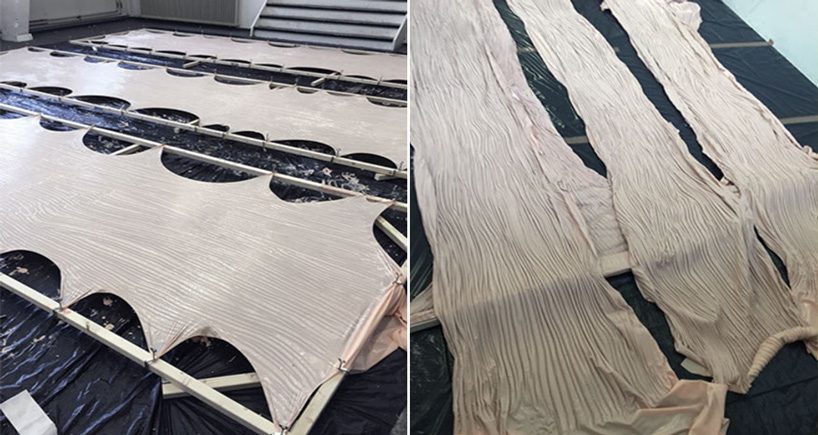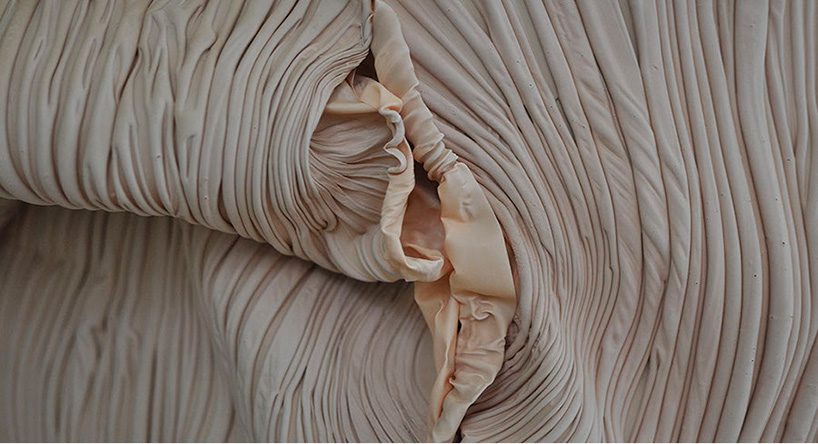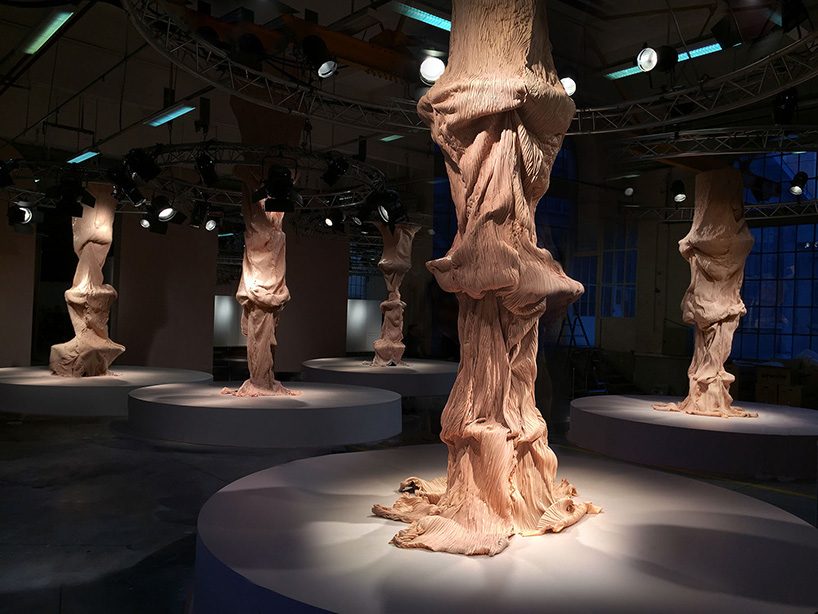04/02,yinka shonibare, costume combined with art
After seeing his work at the welcome collection, i wanted to find out more as his pieces look like costumes yet they are also fine art. This links to both my interests.
Yinka Shonibare, (born February 10, 1962, London, England), British artist of Nigerian heritage, known for his examination of such ideas as authenticity, identity, colonialism, and power relations in often-ironic drawings, paintings, sculptures, photographs, films, and installations. A signature element of his work is his use of so-called Dutch wax-printed fabric, produced by means of a batiklike technique. Exported from the Netherlands and elsewhere in Europe in the late 19th century, the brightly coloured patterned fabric was meant to imitate Indonesian cloth and was enthusiastically adopted in West Africa, so this inauthentic Indonesian textile produced in Europe became known as “African” cloth.
In part because of his experimentation with so many media, Shonibare’s art defies easy categorization. In paintings such as Double Dutch (1994), he created a large work by painting a rectangle on a wall and placing on it a grid of several small stretchers covered with the Dutch wax-printed fabric ubiquitous in his art. He then began using these textiles to create costumes in the Victorian style for mannequins. These brightly clothed mannequins sometimes were headless (Scramble for Africa, 2003) and sometimes had objects such as globes in place of human heads (Planets in My Head, Philosophy, 2011). In such works as Diary of a Victorian Dandy (1998; based on the narrative works of British artist William Hogarth), Shonibare created a series of photographs featuring himself as a dandy in a variety of tableaux. He also portrayed the protagonist of an Oscar Wilde novel in the photographic series Dorian Gray (2001). Many of Shonibare’s works made reference to paintings by earlier artists, among them Jean-Honoré Fragonard, Francisco de Goya, and Leonardo da Vinci. In the 21st century, Shonibare expanded his repertoire of techniques to include films (Un ballo in maschera, 2004, and Odile and Odette, 2005).
ARTICLE FROM https://www.britannica.com/biography/Yinka-Shonibare
MY REFLECTION:
I like the idea of headless costumes because it evokes the masses, also this idea of wax fabric. It makes me think about why he chose this specific fabric, and makes me think more into what i will experiment with for part 3 , as i do want to make some sort of costume even if it is very abstract.
Hussein Chalayan article, transforming fashion, 02/02
When Hussein Chalayan Turned Furnishings Into Fashion
 Chalayan A/W00
Chalayan A/W00
 Chalayan A/W00
Chalayan A/W00
 Chalayan A/W00
Chalayan A/W00
Rebecca Horn, 'arm extension' 09/12
Horns practice interests me greatly as she is using the body to communicate her ideas. The piece below is expressing the paradoxes in her personal desire for intimacy with others, and this theme links to my earlier work on skin hunger but shows a new angle of reflection.
The weight of the arms link to the constrictions of intimacy and show the dilemma of a person who longs for such intimacy but feels restricted.
I love the use of costume, shape and matwri used with the body and this is a clear example of work I want to do.
But is this fine art, fashion, or performance? Perhaps all 3?
Contextual Practice, Tate Britain visit 27.11.19
Monster Chetwynd, 'Jesus and Barabbas', 2018
Can you identify the themes of concerns the artist is exploring in their work?
Issues of democracy, political opinions, bribery in society...Cultural history in general.
What materials, processes and media has the artist used to explore their ideas?
I like the blend of 2D and 3D work here. Photocopies and painting have been used together, but so has draped doll-like structures over it all, with fabric too which could symbolise blood.
How successful do you think their approach is? Why or why not?
I was drawn to this piece as the doll-like figures were very effective and almost frightening...There is something about hanging dolls which is very alarming since usually we associate dolls with kids and playtime. It is almost a type of juxtaposition but could be giving a powerful message that in this case, democracy wasn't taken seriously and lives were literally played with, like kids play with dolls. I felt alarmed and therefore i feel it is effective, and i like the use of 3D on top of 2D..although i actually think if the dolls were hung on a blank background perhaps it could be more effective? As we wouldn't be distracted by the background...Maybe that is just cos i don't understand the background, and it is less provocative.
Can you relate any processes, approaches or themes and concerns that you have identified to your own developing practice?
Yes, definitely with the idea of hanging fabric and figures. I feel it is very effective when it is visibly hung on wood...perhaps i could find wood and use that for draping my designs.
Suzanne Lacy,The Crystal Quilt 26/11
The Crystal Quilt (1985-1987)
This is one of several works by Lacy that explore the experience of aging, and in this case how aging women are represented in media and public opinion. The project was developed over a two- year period during which Lacy created a series of events and classes, including a lecture series, film screenings, and a mass media campaign in collaboration with almost two dozen artists and scores of volunteers. A key part of the project was an Older Women’s Leadership Series designed by Sharon Anderson, a series that brought 35 women leaders from across the state together in seminars at the Humphrey Institute.
This extensive research process culminated in a large-scale performance installation on Mother’s Day in the middle of a Philip Johnson-designed shopping complex with a crystalline roof. The performance featured 430 Minnesota women over the age of 60 seated at tables on an 82-square-foot rug designed to resemble a quilt. Over loudspeakers a pre-recorded sound work mixed personal observations and reminiscences by 72 women with social analysis about the un-utilized potential of the elderly. A loon cry or thunderclap rang through the space at ten-minute intervals, signaling the women participants to change the position of their hands on the table, thus changing the design of the quilt. At the end of the performance, an audience of almost 3000 people flooded the stage bearing hand-painted scarves. As they greeted the triumphant performers, they transformed the austere order of the quilt design into a crazy quilt of color.
Participating artists include Nancy Dennis, Sharon Anderson, Phyllis Jane Rose, Phyllis Salzberg and Judy Kepes. Quilt design by Miriam Shapiro, scarves by Julie A, soundtrack by Susan Stone, choreography by Sage Cowles, and PBS live broadcast produced by Emily Goldberg. ,
I find this work interesting as it is focusing on audience participation, therefore it is engaging to another level with the viewers. I feel performance is key in getting messages across and raising questions because it is more intimate than just looking at an artwork or design it directly involves action.
The fact Lacy has created a physical quilt from this performance shows the power of combining different creative areas which Is what I am interested in doing.
If I were to develop this further I could make the quilt a wearable item and think about marketing it therefore the audience numbers will rise considerably and the messages get across to a greater range of people.
Now I am thinking I could involve performance for my weave rather than just do a weave and get someone to wear it. this is not very engaging with my audience.
so how? I could involve not just my personal items? As in, perhaps interview friends and ask what is personal to them. or even ask directly for a personal item I could borrow....Therefore my overall outcome isn't just related to myself and actually engages more directly with the general population. it will get acrosss the idea of 'exposure of data' and 'owning data' across more clearly.
okay so. now I must document how I interview my friends and make clear notes about what items to borrow.
I should put it into my sketchbook and get them to write down what they are giving me and why it is unique/personal to them.
this shows a variety of creative practices all combined into one. i want to think about fine art, fashion designs and how I communicate it all.
'female beauty' buzzfeed
re-edit research, Candice Breitz, 'Her'. 07/11
This video is powerfully editted in order to amplify the effect of how unjustly women are portrayed in the media, through using footage of Meryl Streep alone.
I find it provocative and effective because simply the fact there is enough footage to make a 7 min video of multiple videos, says enough.
This idea of women being portrayed in the media is interesting and unfair, it is something which we don't realise and need to therefore reflect on more as artists.
It makes me think of sexual harrassment because again, i think this occurs without any thought and is extremely hurtful for women and girls daily; we need to reflect and raise awareness as this is our job as artists.
Being human, 'skin hunger' 05/11
What Lack of Affection Can Do to You
We're facing a crisis of skin hunger, and it has real consequences.
Posted Aug 31, 2013

Recently I wrote about Juan Mann, the founder of the “Free Hugs” movement who felt so deprived of meaningful human contact that he offered to embrace strangers on the street. Perhaps you can identify with Mann. How often do you find yourself feeling lonely, craving more affection than you get? Maybe you wish your spouse or partner were a bit more demonstrative of his or her love. Maybe you’ve tried without success to get certain people in your life to be more affectionate with you, so you go on wishing for more affection than you receive. If any of this sounds familiar, then you’re experiencing a common problem known as skin hunger, and you're far from alone. Consider:
- Three out of every four adults agree with the statement, “Americans suffer from skin hunger.”
- More Americans live alone than ever before.
- One in four Americans reports not having a single person to talk to about important issues.
- Loneliness among American adults has increased by 16 percent in the last decade.
These facts help us understand the nature of skin hunger, which is both an acknowledgment that we don’t get as much affection as we need, and of our drive to get more. We normally associate hunger with food, of course—but we don’t feel hunger simply because we want food. We feel hunger because we need food, just as we feel thirsty because we need water, and tired because we need sleep. Our bodies know what they require to function properly, and research suggests that affection belongs on that list, right behind food, water, and rest.
Just as lack of food, water, and rest have their detrimental effects, so too does the lack of affection. In a recent study of 509 adults, I examined the construct of skin hunger—and the social, relational, and health deficits with which it is associated. The results were consistent and striking. People with high levels of skin hunger are disadvantaged in multiple ways, compared to those with moderate or low levels. Specifically, compared to people with less skin hunger, people who feel more affection-deprived: are less happy; more lonely; more likely to experience depression and stress; and, in general, in worse health. They have less social support and lower relationship satisfaction. They experience more mood and anxiety disorders, and more secondary immune disorders (those that are acquired rather than inherited genetically). They are more likely to have alexithymia, a condition that impairs their ability to express and interpret emotion. Finally, they are more likely to have a preoccupied or fearful-avoidant attachment style; they're less likely to form secure attachments with others in their lives.
These findings don’t establish that skin hunger causes all of these negative conditions, only that people who feel highly affection-deprived are more likely than others to experience them. If you’re one of those people, though, these findings probably come as no surprise. Affectionate contact is so necessary for a healthy life that we suffer when we don’t get enough.
Fortunately, skin hunger doesn’t have to be a permanent condition. Each of us has the capacity to get more affection in our lives. In the meantime, put down your cell phone and share an affectionate moment with someone in person. For those with skin hunger, human contact—not the technologically mediated variety—is the cure for what ails.
https://www.psychologytoday.com/gb/blog/affectionado/201308/what-lack-affection-can-do-you
Reflecting on this article, it is clear that today there exists an issue of 'skin hunger' which is a result of advances in the digital world...therefore, we must create a clear message in our outcome that specifically responds to this dilemma today.
For instance, we could involve sensual work? Or even simply filming of skin touching? Maybe use the human body in a performance alongside the video? Tomorrow we will go over ideas and refine what to do in order to be most successful here.
Quote from 'the body in contemporary art' by Sally O Reilly, 08/02
I find this quote interesting when looking at what inspires artists today.
It gives the idea that we are now less interested in big issues because we are drawn to how we interact in society, and small acts of what we do as humans.
I relate to this idea as I think society is my key inspiration, and the fact that this is becoming a norm for artists makes sense as religion and other big issues are being forgotten in many cultures.
Franz West, interactive sculpture, 22/01
TAKEN FROM website gagosian.com
About
From abstract and interactive sculpture to furniture and collage, Franz West’s oeuvre possesses a character that is at once lighthearted and deeply philosophical. Belonging to a generation of artists exposed to the Actionist and Performance Art of the 1960s and 70s, West instinctively rejected the idea of a passive relationship between artwork and viewer. Opposed to the existential intensity requisite to his performative forebears (such as Actionism), he produced work that was vigorous and imposing yet unbounded and buoyant. In the seventies, he began creating compact, portable, mixed media sculptures called “Adaptives” (“Passstücke”). These “ergonomically inclined” objects were actualized as artworks only when touched, held, worn, carried, or otherwise physically or cognitively engaged. Transposing the concepts engendered by these formative works, he explored sculpture increasingly through the framework of the ongoing dialogue between viewers and objects, while probing the internal aesthetic relations between sculpture and painting. Manipulating everyday materials and imagery in order to examine art’s relation to social experience, West revolutionized the interplay of concealment and exposure, action and reaction, both in and outside the gallery.
My reflection
I love the idea of art only being art when it physically engages with its audience. I want to intertwine this theme of interaction and sculpture with playing around with the human body.
I am thinking of creating a sculpture with has to be worn, but it is up to the audience how they wear it....Sort of interactive fashion, costume which is played with.
Therefore my audience will have to think about the art, and actually playing with it physically creates a new sense of connection.
It reminds me of the play well museum as adults are only children but bigger..we all learn from play.
therefore I want my art to actually be played and interacted with directly on the body
quote from his article...''he explored sculpture increasingly in terms of an ongoing dialogue of actions and reactions between viewers and objects in any given exhibition space''
Petr Stembera, 06/01
This artist used his body as his canvas and basis, and incorporated nature which is what Lux is looking into as nature is a part of greenspaces
Petr attempted to graft a plant to his arm and used the same gardening techniques used with plants and soil. Therefore he actually cut open his arm, syringed chemicals into it used for growth and implanted the plant.
It looks at personal messages of absorbing an alien culture into one's own so links to identity. it reminds me of things being out of place, and also the idea of nature and man being at one with each other. this is the aim of a greenspace, so i think this art links well
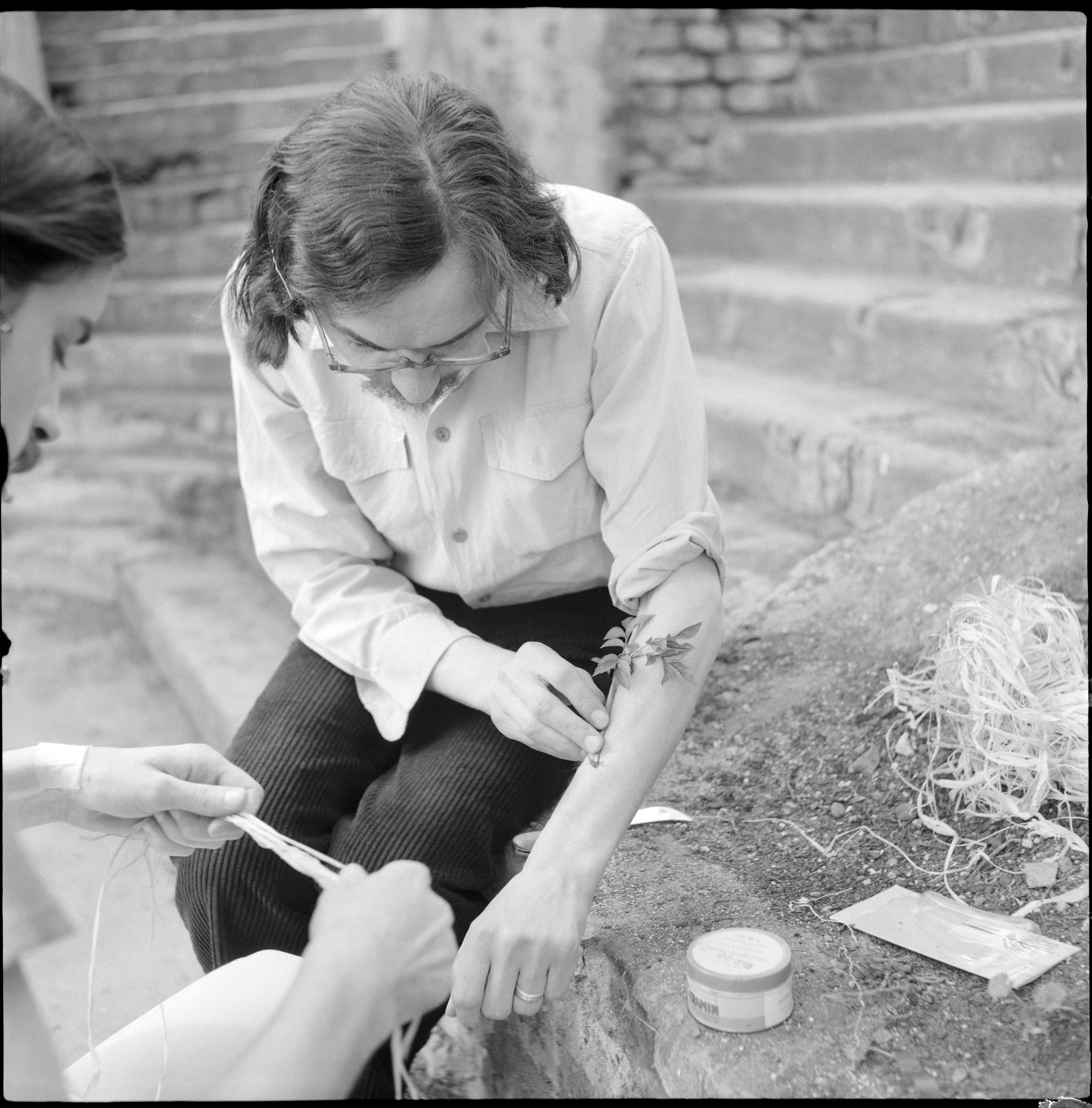
Rebecca Horn, 'finger gloves', 09/12
This body sculpture piece links again to the idea of deprivation of intimacy, which I believe is becoming more and more of a serious issue due to advances and addictions with technology.
This gives another angle compared to arm extensions, as it makes the performer somewhat empowered through the ability to grasp objects from a long way off. However it still links to restriction as it isolates the wearer from her environment.
I am interested in how Rebecca came up with these ideas and sculpures and I am also thinking how could I create some sort of body sculpture linked to my project.
Sound waves are very unique and their structure could be interesting to make.
I might try using simple materials like wooden sticks first and see what happens. I must connect my sculpture to the body in a way that communicates my theme of exposure of personal data. And lack of identity?!
If it is interactive then it will automatically be exposed. And I coukd use thread to link to the detailed intricate structure.
Emily Lazerwitz, 02/12
''Her artistic practice deals with the issue of time and focuses on the intersection of art, craft, technology, and language. More specifically Lazerwitz is concerned with the way technology shapes the direction in which language develops.
"Having grown up with the development of the Internet and social media, I have witnessed very personally how the expansion of these innovations has changed who I am and how I communicate. I am excited by the prospect of being able to interact instantaneously with anyone in the world through audio, visual, and written means. However, these same technologies also limit my use of language through restrictions on length and vocabulary. Long beautiful prose from past centuries currently has no place in this new environment and that scares me.
To overcome this fear, I turned to my art and focused on ways to render words completely meaningless as both a prediction and protest to what I see happening. The craft forms of quilting, weaving, and needlework became my visual language of choice to explore this consequence. These practices have been passed down for centuries and involve precision, time, and acquired skill, while social media platforms function through universal accessibility, short cuts, fragments, and speed. The tension between these two forms drives my practice.
Every piece takes weeks to make. They require painstaking concentration, as well as time to understand and literally decode the messages. The logic is purely my own and becomes a privileged knowledge for the few who spend the time to really look.
How soon is it until we no longer use words or even letters just simply ones and zeros?" ''
TAKEN FROM https://unframe.london/contemporary-art-artist-london-emilylazerwitz/
My reflection to this article:
The use of unique methods of traditional methods of communication is clever because she is commenting on the result of technology on language and communcation.
technology is beginning to remove our identity, especially via language and our traditions in communication.
i am exposing data rather than looking into loss of tradition/identity, but it links as i want to visually show my data and her traditional methods are a possible option.
Soundwaves interests me most, because they have a unique shape and are clearly showing information in a visual form.
i like her use of weaving and embroidery, because weaving can be used easily to demonstrate ideas and merging links together
I will try out weaving and the use of soundwaves in my project via experimentation with looms and photoshop
'being Human' exhibition 20/11
I find this piece especially inspiring and brave. The fact Roseline is using art to actually help frightened patients, and for actively making a difference, is amazing. I have kept an image of the context as it shows Roseline’s determination and bravery. It makes the viewer feel the importance of visual art but also aware that we have it easy…we should take inspiration from Roseline and be brave even if its by small acts.
'sea of data' 21/11
Vision loses importance
and is replaced by
filtering, decrypting,
and pattern recognition
Not seeing anything intelligible is the new normal. Information is passed on as a set of signals that cannot be picked up by human senses.
The spectrum of human vision only covers a tiny part of it. Electric charges, radio waves, light pulses encoded by machines for machines are zipping by at slightly subluminal speed.
Automated Apophenia
Inceptionism does that and more. It also gives those forces a face—or more precisely, innumerable eyes. The creature that stares at you from your plate of spaghetti and meatballs is not an amphibian beagle.
Are we to assume that machinic perception has entered its own phase of magical thinking?
After reading this article, I want to develop my idea of a portrait weave into something more abstract. I could take data codes and create a weave of this combined with the portrait? Or perhaps something else which is built using data but creates a form of mechanic perception for the viewer. I want to create a garment of data that links to 'wearing your own data' yet also 'exposing your own data'; a sort of juxtaposition.
Data. what can is be visualised as?
14/11, body projection idea - Thomas Mailaender
thomas mailaender ‘sunburns’ old photographs onto human bodies
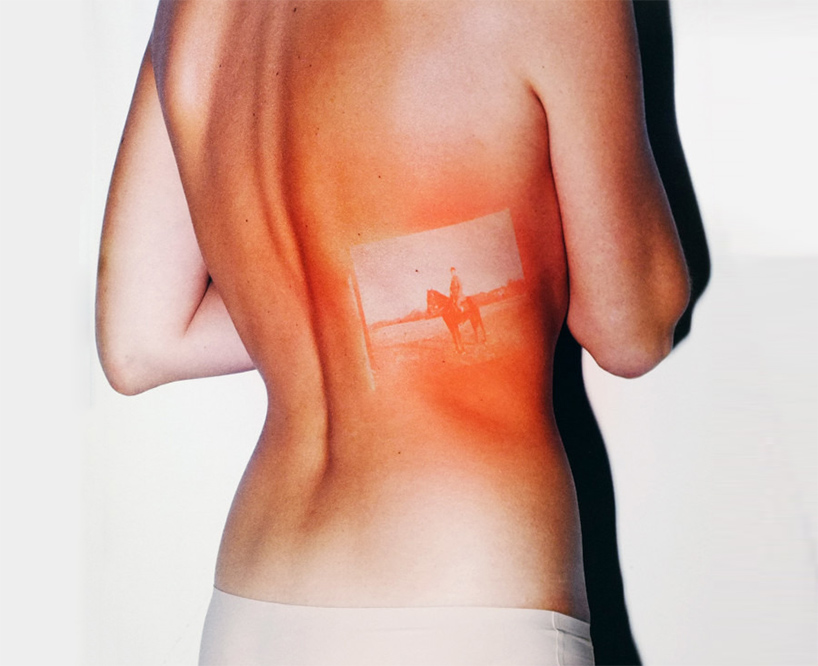 image courtesy of thomas mailaender
image courtesy of thomas mailaender
french artist thomas mailaender manifests an artistic performance in pictures, illustrating the product of his ephemeral and experimental body artworks. the images show the result of the artist’s work with UV light: mailaender applied 23 original negatives from the archive of modern conflict’s collection onto the skin of models, before projecting a powerful UV lamp over them. the result reveals a fleeting picture on the skin’s surface, which he photographed just moments before exposure to daylight caused them to disappear.
My reflection: I like this idea of projecting onto the human body because it makes the art more intimate, and turns it into almost fine art fashion...I am thinking now, how can i do this with my video? I don't want to simply copy the artist so i will put my own slant on it.
Perhaps i could use myself as a sort of performance and video the original video being projected onto my skin. It could be my tummy, back, arm, anything.
I also find this art interesting as it is clearly reflecting on issues in our world, in which conflict is becoming a primary concern and we all hear about it daily on the news yet it doesn't change...But how can we help? As artists, what could we do?
'female beauty' buzzfeed reflection 11/11
I find this video relatable and easy to understand, so therefore it is a great piece of art for connecting to a big part of its audience. the idea of standardized beauty interests me, and since i am trying to find footage for my re-edit video tomorrow, i am now thinking i could look into something along these lines? Perhaps i could intertwine the issue of how women are depicted through media, as the videos we saw in class today i also found inspiring...This video is simple and effective and i want to create something which also connects to its audience.
To develop my idea, i could project it onto the human body as therefore it shows society's impact on actual people. I am wondering if i should angle my footage specifically to the beauty industry...advertising or fashion perhaps? i will continue my research into both of these, but it would be interesting to involve old footage and show the evolution of how beauty is depicted, then project it onto the human body.
Bart Hess, 'grotto', 07/11
bart hess manipulates pink latex to resemble wrinkled human skin in grotto installation
'The Next Black' Documentary, 07/02
| DETAILED INFORMATION | |||||
|---|---|---|---|---|---|
| Project Name | THE NEXT BLACK | Posted in | FASHION, FASHION DESIGN, TEXTILE DESIGN, VIDEO | Creative Agency | RADON |
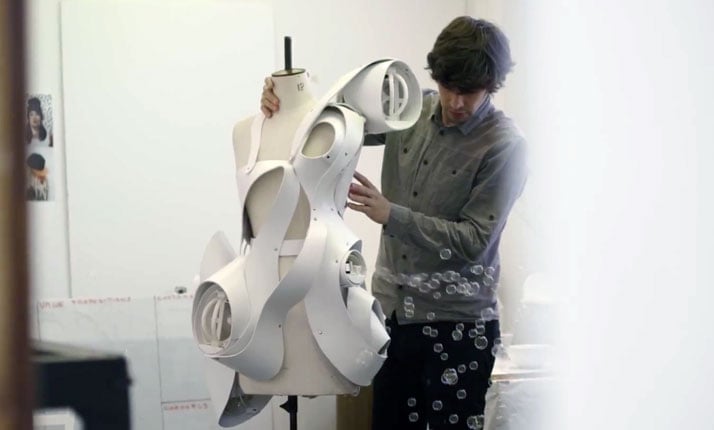
Studio XO, photo © The Next Black, AEG.
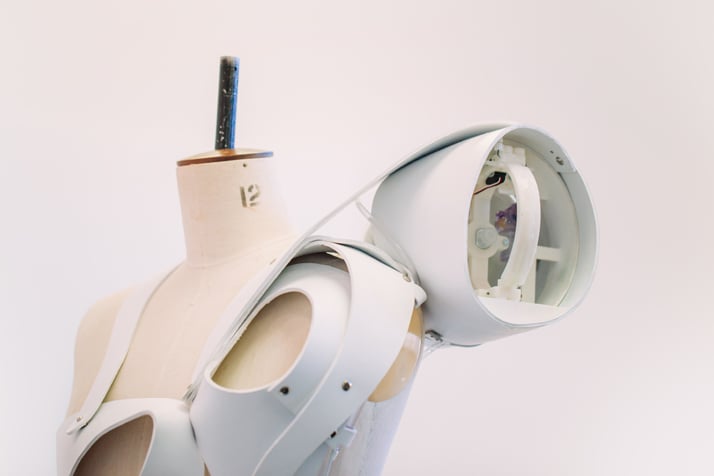
Studio XO, photo © The Next Black, AEG.
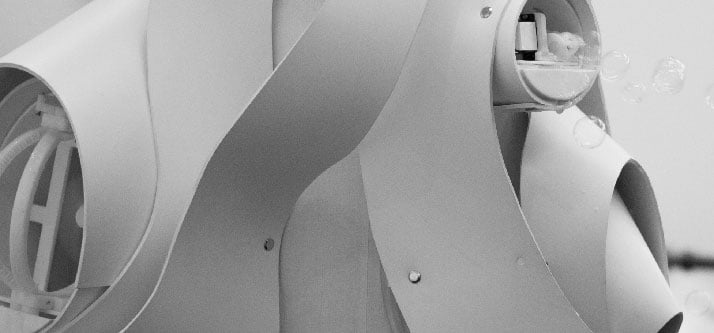
Studio XO, photo © The Next Black, AEG.
The progressive people that are answering these questions include Rick Ridgeway, environmentalist, mountaineer and Vice President of Environmental Initiatives at Patagonia, one of the most sustainable companies in the fashion industry, Nancy Tilbury, co-founder and director of Studio XO, a company that specializes in the area where fashion meets technology, Matt Hymers, project manager of Team Elite System, one of adidas’ latest inventions (who demonstrates the system of woven sensors in the shirt that send real-time data of the players’ performance), Suzanne Lee, the founder of Biocouture Ltd, which works with materials grown from living organisms and lastly, Sophie Mather, Innovation Director of the Yeh Group which has pioneered a new way to dye clothes using zero water.
The concept of clothing is changing and it’s our mission to explore it!
^ article from https://www.yatzer.com/next-black-film-about-future-clothing
MY REFLECTION:
This documentary highlights the need for experimentation of materials in order to sustain our planet, and avoid fast fashion. It is an issue which i feel is extremely overlooked and needs to be changed, so the idea of creating a new type of fabric out of bacteria is so interesting to me.
it makes me excited for part 3 because i want to try experiment with weird materials such as bacteria here, in order to make a new fabric that i can use for a costume on the body.
'Being Human' exhibition 20/11
Latai
I like this work because in intertwines refelctions on issues around us, climate change here, with working on the human body. This makes the work more intimate and provocative by designing onto a naked body where lots of skin is kept on show.
I also find the use of collage highly effective as its simplicity gets across climate change very successfully.
I’m thinking I could experiment with collage using photoshop, perhaps blending my ideas of visualising data with clothing on the body by doing so.
visualizing data, 21/11
In turn, there’s been what the Pew Research Center calls a self-tracking explosion, whether it’s counting the number of calories or using a mood app to glean patterns in one’s mental state. Like a fingerprint, no two people have the same data set. A couple sharing a bed follow independent sleep cycles. Friends who spend the day together count different steps; their phones connect to different IP addresses. But what’s more remarkable is the idea that within all of these numbers lies a better way of understanding ourselves. The information doesn’t just provide a broad document of a life lived in the early 21st century: It can reveal something deeper and even more essential.
https://www.theatlantic.com/entertainment/archive/2015/05/the-rise-of-the-data-artist/392399/
Visualising data, 21/11
Japan House 'wow' exhibition, 17/01 REFLECTING ON UPLOADED CONTENT
I found the immersive video room experience extremely enlightening and enjoyable. It felt like I was actually there, like on a roller-coaster, or in the tube, and the speed of it all was really effective.
It has made me think about how one can use projection of a whole space to connect with one's audience in a new, innovative powerful way.
This week we are experimenting with projection so I will try using the dark room and multiple projections for a similar immersive effect.
As for the projection onto the poppa dolls, this was also effective and very clever.
I like the idea of notnjusy projecting onto a wall, but using sculpture and materials to add another dimension to my projection.
Lucy Orta, Architectural Fashion, 14/01
Lucy's work inspires me as it is combatting general associations of fashion, and going into new mesures such as audience interaction. therefore her designs are artpieces and actually make a difference in society.
Her designs for 'Refuge Wear' involve designs which look like literal sleeping bags, as she is commenting on our ignorance of homelessness.
To quote Lucy, (her work) 'breaks down barriers between clothing and architecture to remove many of the limitations they represent, with the intention of eventually leading to some sort of transformation.'
Ie lucy wants to create change with her fashion, and not just cause new trends. this is inspiring and her ideas i find interesting and key to our society today.
Her sculptures aren't to be worn, but are to create a reaction and provoke a social awareness. I believe she has recognised fashion's true potential to actually make an impact on the level of social conciousness.
Refuge Wear continues to engage fashion with disciplines ranging from architecture and art to social regeneration and ideological activism. She began to start workshops looking at impressions of home and perceptions of the body.
this idea of designing for the body in order to create positive social change really inspires me, and i am interested in trying out similar ideas for themes i want to change. for me personally, this could be food waste as i am fed up of watching decent food be thrown away.
Adam chodzko, adaptation, 02/01
I find this work hard to understand and appreciate. The video is long and the conversation doesn’t seem to make total sense, which makes me feel close minded. I plan to continue watching it and try relate to the overall message.
However I really like the aspect of lights used, as it makes the video come to life as it is filmed in darkness.
I am thinking I could incorporate lights somehow into my project; fairy lights perhaps? I want the focus to be on the human body’s relationship with greenspace therefore I could alluminate the body with a costume of fairy lights. This would be effective if filmed in the dark in a greenspace?
Nottingham science museum, 07/12
I am wanting to look more into structures and 3D waves of showing data.
This is to go outside my comfort zone and try new things
This museum had lots of intricate designs and bone structures which I found interesting so I captured zoom ins of the actual structutes... I like the abstract outcomes and am thinking how I can incorporate such unique structure into my project
Antony Gormley at R&A, 25/11
This room was unique and has been in my mind since because of the use of presentation...The way the human structures come out at the audience at all different angles makes the art more intimate and interactive. The audience has to duck or look up and actually makes us look at the art in different ways.
I am beginning to realise the importance of presentation of work...If these sculptures were shown normally just on the ground, the effect on us wouldn't have been the same at all. Here, the way it is shown is almost more important than the art itself.
I need to clearly think about how to present my garments. It must be key and link to my message.
Since i am looking into exposure of data and looking into ownership of data, i must give my presentation a simple look as i want to raise questions.
I won't make a video. or present images...
I will hang my garments in either a really exposed position or a really hidden one. the designs will be hidden since they will drape downwards. So i think expose them on the beam? this will be clearly out in the open, and create interaction as everyone will have to brush them aside to walk through it.
Therefore it is an interactive piece as well as a garment!
Antony Gormley at R&A, 25/11
'Exercise between blood and earth', 2019, chalk
This piece stood out to me because it links clearly to personal identity: a fingerprint is what we have used for years now to identity genes and identity. It is possibly the most personal form of ourselves that can we recorded as data.
Therefore i am thinking of including a fingerprint design on a garment in my series of 'wearing data'.
I like the use of red chalk as it contrasts with the wall, and the fact it isnt in a frame makes it more interesting to normal framed art.
I want to present my collection in a unique way. i am thinking either via a video or simply hanging the material, so the patter isn't exposed as exposure is my key theme here...exposure of data
'Being Human' exhibition 20/11
Latai
I like this work because in intertwines refelctions on issues around us, climate change here, with working on the human body. This makes the work more intimate and provocative by designing onto a naked body where lots of skin is kept on show.
I also find the use of collage highly effective as its simplicity gets across climate change very successfully.
I’m thinking I could experiment with collage using photoshop, perhaps blending my ideas of visualising data with clothing on the body by doing so.
Nora Ligorano, datafied research, 19/11
Overview
Goals
Process
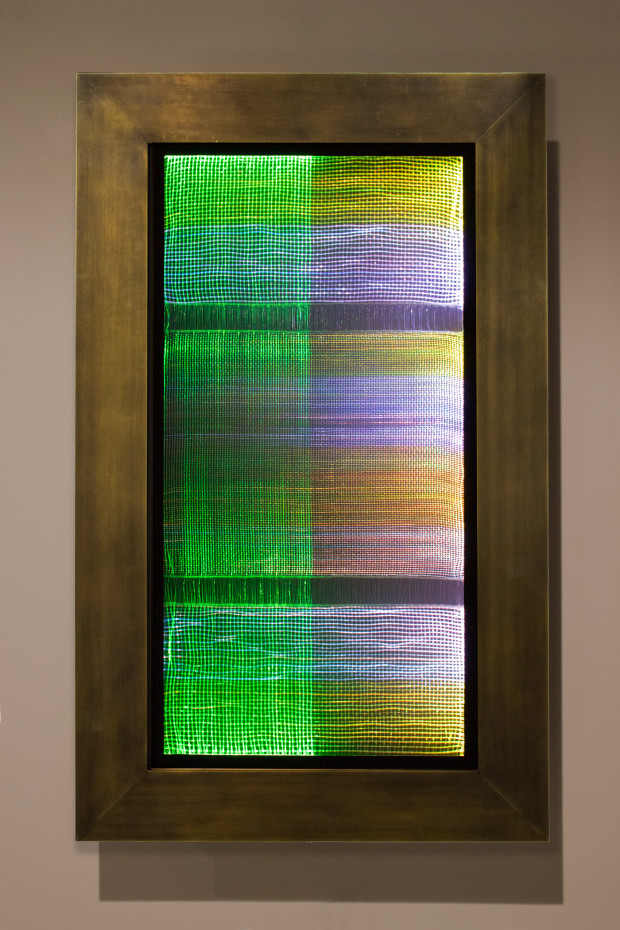
'play well' exhibition 20/11
Here is a weave used with coloured paper…It is simple yet effective, and makes me think of my pixilated images created on photoshop.
I am going to use this paper weave idea and create a white weaving then paint with watercolour over the top.
This should get across the pixilated, data-like effect for my portraits.
lee griggs, conceptual body art, 14/11
using digital tools, spanish designer lee griggs has created a series of facial ‘deformations’. the collection depicts incredibly realistic and human-like figures — eyes, noses and mouths are delineated with exact and precise dimensions, scale, shading and perspective. however, it is immediately evident that each of the virtual people, despikiko shinzato focuses another skin jewelry collection on enhancing one’s face
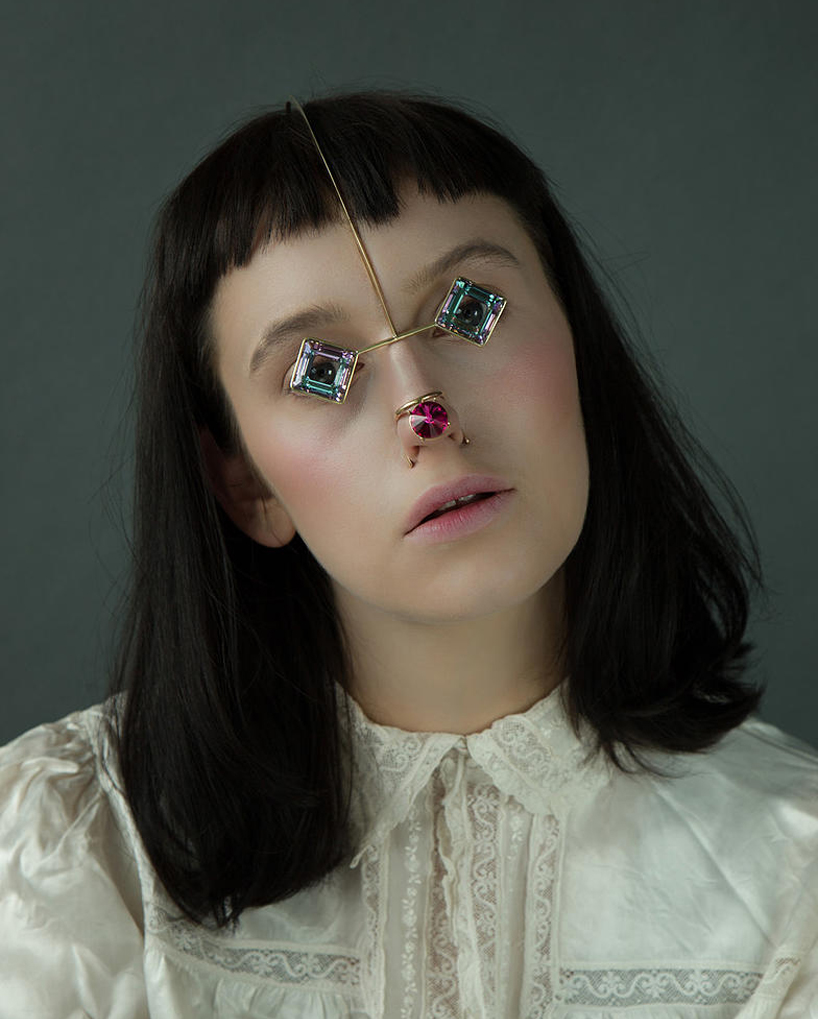 photo by runa anzai, courtesy of akiko shinzato
photo by runa anzai, courtesy of akiko shinzato
observing societal behaviors and our pursuit for beauty and physical attractiveness, akiko shinzato has delicately crafted ‘another skin’, influenced by the aesthetic and structural idea of a pair of pince-nez — a style of glasses used throughout the 19th century that simply pinched someone’s nose to stay in place, rather than using the support of arms. the collection of jewelry addresses the part of the body that is focused on during the first impression, and what people seem to care about most: the face. utilizing precious materials such as leather and crystal, in combination with soft metals, the london-based designer explores how easily one can change their appearance.
https://www.designboom.com/art/top-10-body-art-2015-12-18-2015/
I find this sort of body art extremely fascinating, because it is involving conceptual work, provocative art and the actual process of making for the human body. The ideas behind this piece interest me as i have always questioned why we all focus on certain appearance parts subconsciously, and studies show that it is an instinctive thing we cannot control; we first look at eyes, then lips, skin...there is some sort of order. It is as if humans are set up like robots when you think like this.
I am going to stick to my ideas of depictions of women in media for re-edit project, but keep this piece in mind for future.
Senga Nengudi, 08/11
''Works such as R.S.V.P Reverie ‘T’ (2014), with its sand-filled balloons of nylon, conjure bodily let downs (in all senses of those words) of a particularly feminine kind. The sand-stretched nylon captures the sag of the breasts or the pillowy roll of the belly, the spent elasticity of flesh that has been stretched and stuffed for childbirth. ''
https://frieze.com/article/senga-nengudi

R.S.V.P X, 1977/2014, activated by Maren Hassinger, 2014
Senga Nengudi's art has always stayed with me since i visited the henry moore institution. Now, i am thinking back to her use of tights and stretching of materials since i can link this to my current project...Tights are fragile, like skin, and so stretched tights = restrained skin? SKIN HUNGER.
I am thinking how i could drape the tights over the body. I am also thinking, i could focus on specific parts of the body which show intimacy...bras and knickers for women are the most intimate clothing pieces. I could use tights, draping, moulding to create literal skin pieces?
Perhaps i could extend my idea and it could be a 'try it on' interactive piece. Therefore i am having a more personal relationship with my audience, and the fashion item is now an art piece also.
I finally feel back to my usual self, i feel motivated and enthusiastic. Working on the body is what i want to do.

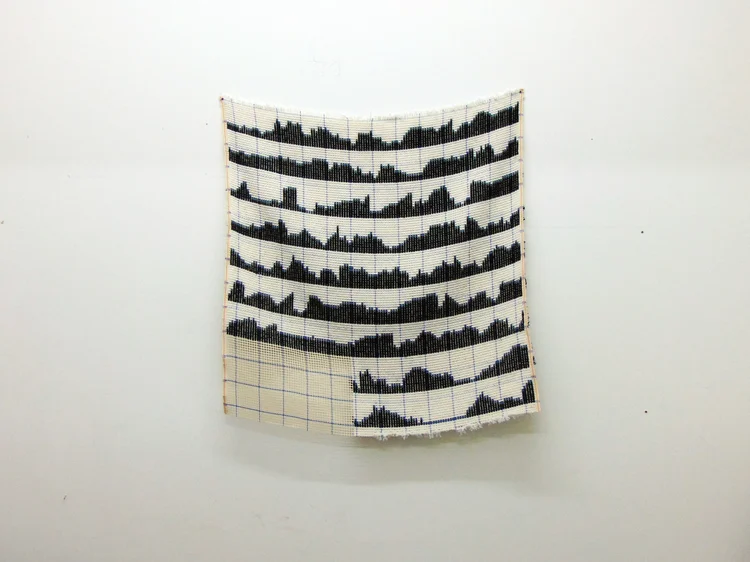
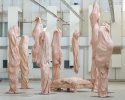
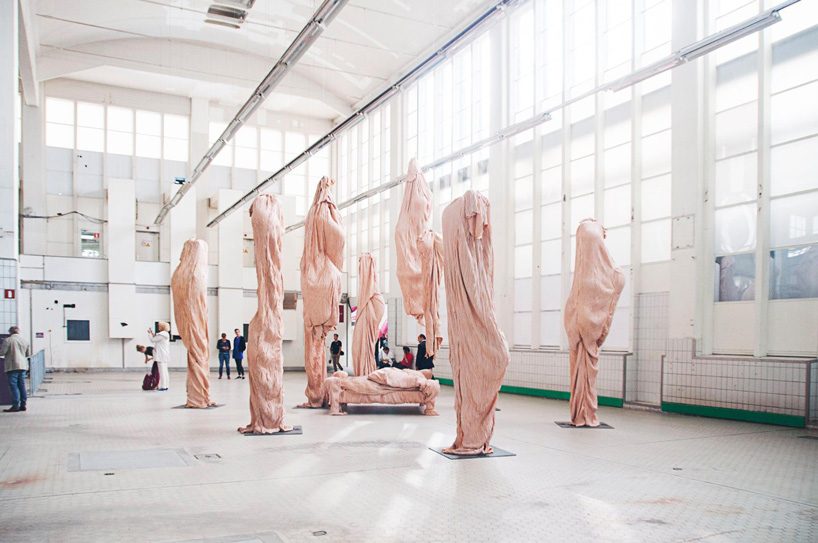 photo by
photo by 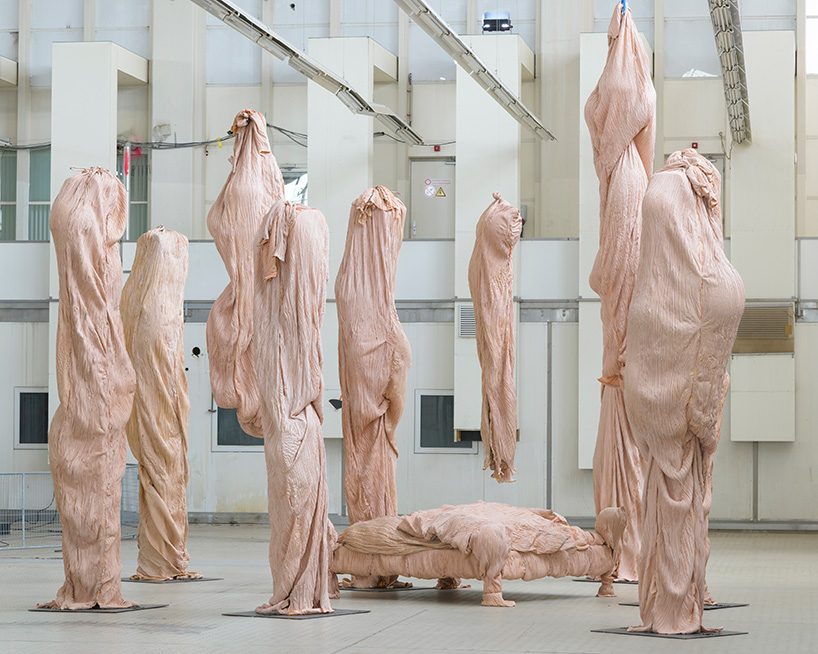
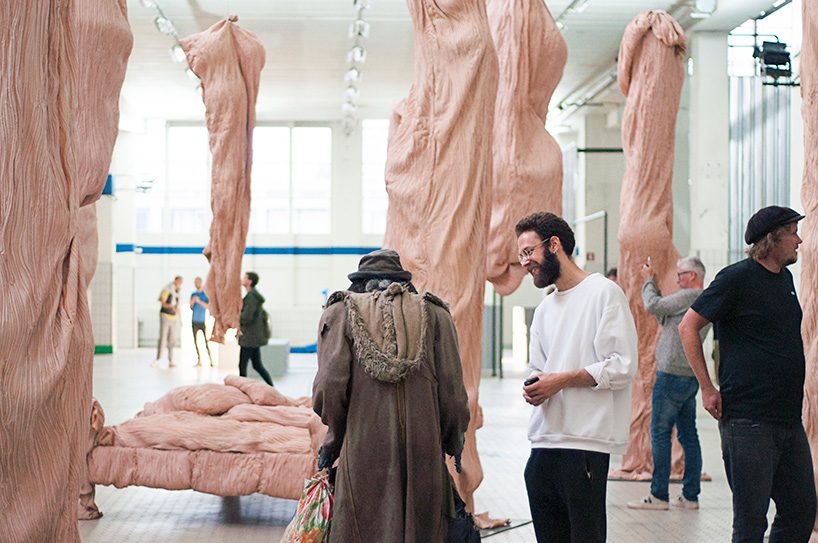 photo by elske nissen
photo by elske nissen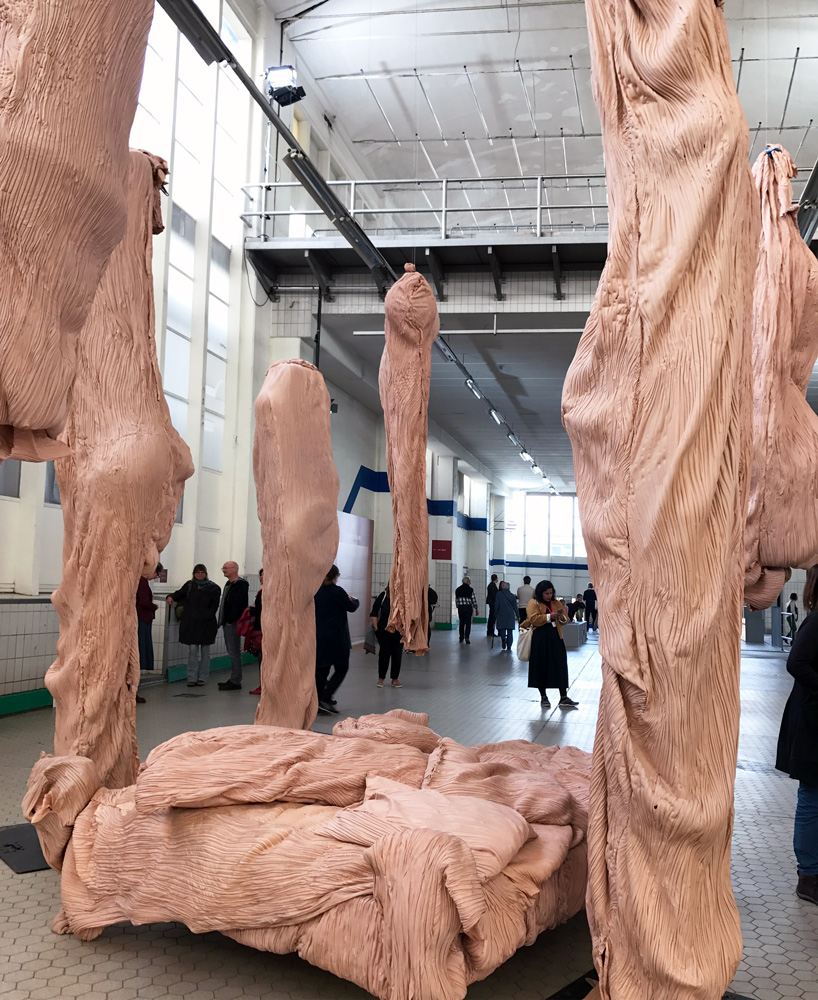 image © designboom
image © designboom